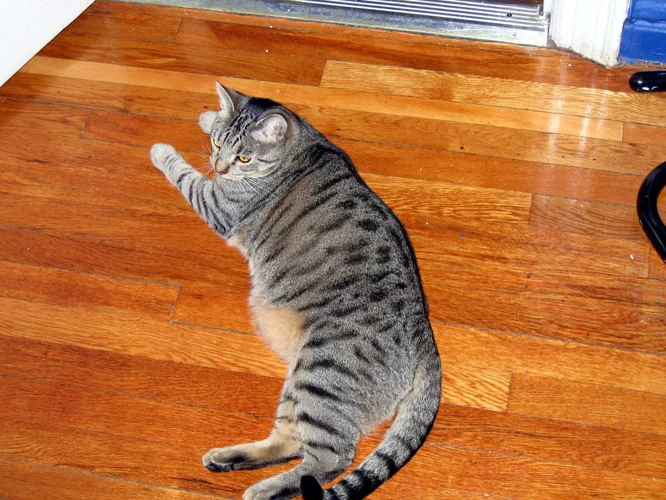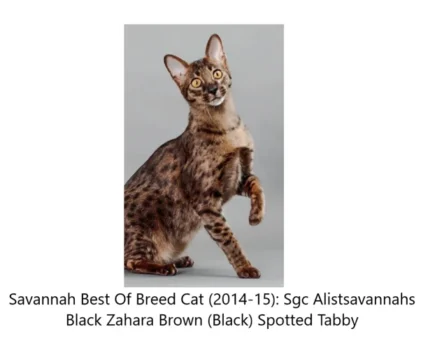Have you ever considered taking your California Spangled on walks with you, just like a dog? It might sound like a strange idea at first, but leash training your cat can be a fun and rewarding experience for both of you. Not only can it provide your feline friend with some much-needed exercise and mental stimulation, but it can also allow for a stronger bond between you two. In this comprehensive guide, we’ll walk you through the process of training your California Spangled to walk on a leash, from preparing your cat to choosing the right equipment and acclimatizing your cat to the leash. So, grab a leash and get ready to turn your indoor cat into an outdoor adventurer!
Getting Started

Are you ready to start leash training your California Spangled cat? Leash training is not only a great way for your cat to get exercise and mental stimulation, but it also strengthens the bond between you and your furry friend. Before you begin, it is important to prepare your cat both mentally and physically, and to choose the right equipment. Let’s dive into the details of getting started with leash training your California Spangled cat.
Preparing Your Spangled Cat
Taking your California Spangled outside for walks on a leash can be a fulfilling and exciting experience. However, before starting off on the leash training, a few initial preparations for your feline friend need to be taken care of. By following these important steps, you can set your California Spangled up for success and ensure that the leash training experience is comfortable and safe for them.
| Preparation | Description |
|---|---|
| Visit the Vet | Before you begin leash training your California Spangled, make sure your cat is healthy enough to engage in physical activity, and is up-to-date with their vaccinations. Get a complete check-up to make your pet is ready to start this new adventure. |
| Get a High-Quality Harness | Choosing the right harness is crucial to the success of your leash training. Avoid collars, as they can be dangerous and cause harm to your California Spangled’s neck. Instead, choose a sturdy and well-fitting harness that is comfortable for your cat to wear. |
| Practice Handling Your Cat | Before attempting to put the harness on your California Spangled, gently handle and touch their feet, tail, and ears. This will help your cat adjust to your touch and make the harness fitting process less stressful for them. |
| Positive Reinforcement | Encourage your California Spangled with positive reinforcement during training. Use treats, toys, and plenty of affection to show your cat that leash training is a fun and exciting experience. Don’t forget that cats thrive on positive reinforcement, so reward them generously for their progress. |
Taking these preparatory steps can make your California spangled feel comfortable and confident with the new experience of walking on a leash. With these initial steps accomplished, it’s time to move onto the next stage of leash training- acclimatization. Follow the next steps carefully and patiently to make it a rewarding experience for both of you.
If you want to learn more about the benefits of leash training your California Spangled, head to our article on the benefits of leash training California Spangled cats.
Choosing the Right Equipment
Choosing the Right Equipment
Choosing the right equipment is crucial when it comes to leash training your California Spangled cat. Here are some guidelines on what to look for when choosing the right equipment:
- Choose a Harness – A harness is more suitable than a collar for leash training your cat because it is more secure and comfortable. A collar can put pressure on your cat’s neck which can cause injury or discomfort, so it is best to avoid using one.
- Pick the Right Size – Make sure you measure your cat’s chest to ensure that you get the right size harness. If the harness is too big, your cat might slip out of it, while if it’s too small, it can be uncomfortable and restrict movement.
- Choose a Comfortable Material – Look for a harness that is made from a soft, lightweight, and breathable material that won’t irritate your cat’s skin or fur. A good choice is a harness made from nylon or mesh fabric.
- Select a Suitable Leash – A standard leash of 4-6 feet would be a great choice for a California Spangled in terms of giving your cat enough room to roam, while still keeping them close enough to you to prevent them from running off.
When choosing the right harness and leash, you should also consider their durability, adjustability, and ease of use. Selecting the right equipment sets you up for success with your California Spangled’s leash training and takes you one step closer to enjoying outdoor activities with your furry companion.
If you want to learn more about the various types of leashes available for California Spangled cats, check out our guide to the best leashes for California Spangled cats.
Leash Training Your Cat

Leash training your California Spangled cat can seem like a daunting task at first, but with patience and persistence, it can be a rewarding experience for both you and your furry companion. Before moving on to the actual training process, it’s important to ensure that you have readied your cat for the experience and equipped yourself with the right gear. If you haven’t done so yet, be sure to check out our previous sections on preparing your Spangled cat and choosing the right equipment before proceeding with leash training. Once you are fully prepared, you can begin with the following steps.
Acclimatizing Your Cat to the Leash
Acclimatizing Your Cat to the Leash
Before you start leash training your cat, it’s essential to get your cat used to the leash to avoid fear, anxiety, or discomfort. Here are the steps to get your cat acclimatized to the leash:
- Introduce the leash to your cat: Start by showing your cat the leash and let them sniff it. Allow them to play with the leash and rub themselves against it so they can become familiar with the feel and smell of it.
- Attach the leash to the collar: Once your cat is comfortable with the leash, attach it to the collar, and let them walk around, dragging the leash behind them. This will get them used to the weight and feel of the leash.
- Shorten the length of the leash: The length of the leash should be gradually increased until your cat can comfortably wear it while walking. It’s recommended starting with a shorter leash length so that your cat does not feel overwhelmed.
- Practice indoors: Start by practicing walking your cat indoors while keeping the leash loose. This will allow them to understand that the leash is a normal part of their routine and not a source of confinement.
Remember that every cat is unique, and they may take more or less time to get comfortable with the leash. Be patient and go slow, so your cat doesn’t feel overwhelmed or scared. Also, make sure that you use the right equipment to make the process comfortable for your cat.
If you want to learn about the common mistakes to avoid during leash training, check out this article. If you want to know how to start leash training with a kitten, this article will be helpful. For more tips and tricks on Cali Spangled leash training, this article has got you covered.
Start Indoors
One crucial step in leash training your California Spangled is to start indoors where your pet feels comfortable and secure. This will help to acclimate your cat to both the leash and the sensation of being guided.
To get started, prepare a safe indoor space with minimal distractions. Place your cat’s collar or harness on them and attach the leash. Make sure the leash is long enough that your cat can move around without feeling restricted, but not so long that they can get tangled or trip.
Table: Tips for Starting Leash Training Indoors
| Tips | Why it’s important |
|---|---|
| Start Slowly | Gives your cat time to adjust to the new sensations and gain confidence. |
| Use Treats and Praise | Associates positive reinforcement with the experience and encourages your cat to cooperate. |
| Stay Close to Your Cat | Offers reassurance and allows you to guide your cat gently. |
| Watch Your Cat’s Body Language | Allows you to identify signs of stress, fear, or discomfort and adjust accordingly. |
| Limit Training Time | Prevents your cat from getting overwhelmed, bored, or agitated. |
Once your cat is comfortable wearing the leash and collar or harness indoors, you can start training them to follow you. Begin by walking slowly and making enticing noises, such as clicking your tongue or using a toy. If your cat follows you willingly, reward them with a treat and praise. If not, stop and give them time to get used to the leash before trying again.
Remember, leash training takes time, patience, and consistency. Be sure to follow these tips and stay attuned to your cat’s needs and comfort level. With practice, your California Spangled can learn to love going for walks on a leash.
Training Your Cat to Follow You
One of the most important parts of teaching your California Spangled to walk on a leash is getting them to follow you. Here are some steps you can take to make this happen:
Step 1: Start by gently pulling the leash in the direction you want your cat to go. Say your cat’s name in a soft, encouraging tone and offer a treat as a reward for following you.
Step 2: If your cat does not follow you, stop and wait for them to come to you. Do not pull on the leash or force them to move. This can cause your cat to become scared or stressed and may make them resist the training.
Step 3: Repeat this process several times, gradually increasing the distance between you and your cat. Eventually, your cat should start to follow you willingly.
Step 4: Once your cat is following you consistently, try changing directions. This will help your cat learn to pay attention to you and not just follow the leash.
Step 5: As your cat becomes more comfortable with following you on the leash, you can try practicing in different environments. Start in a quiet, familiar place and gradually work up to busier areas with more distractions.
Remember, training your cat to walk on a leash takes time and patience. Don’t get discouraged if your cat doesn’t get the hang of it right away. With consistent training and positive reinforcement, your California Spangled can become a pro on the leash.
Going Outside
As your cat becomes comfortable walking on a leash indoors, it’s time to take them outside to continue their training. However, it’s important to take certain precautions to ensure their safety and well-being. Here are some tips for going outside with your California Spangled:
| Tip | Description |
| Choose a quiet area | When you’re first starting out, it’s best to choose a quiet area with minimal distractions, such as a fenced-in backyard or a quiet corner of a park. This will help your cat stay focused and feel less overwhelmed. |
| Stay close to your cat | As you venture outside, your cat may become more curious and want to explore. Make sure to stay close to them so that they don’t wander off too far and get lost or hurt. |
| Be aware of your surroundings | Always keep an eye out for potential hazards like other animals, busy roads, or areas with poisonous plants. Your cat’s safety should always come first. |
| Go at your cat’s pace | Let your cat set the pace. If they seem nervous or uncomfortable, slow down and let them take their time. Remember, leash training is a process and each cat is unique in their own way. |
| Give breaks | Just as with humans, your cat will need breaks throughout the training session. Take frequent breaks (every 10-15 minutes) to let your cat rest, use the litter box, and hydrate. |
By following these tips, you’ll be well on your way to teaching your California Spangled cat how to walk confidently on a leash outside. Remember to always stay patient and give your furry friend plenty of positive reinforcement along the way.
Additional Tips for Successful Leash Training
As you continue to train your California Spangled to walk on a leash, there are some extra tips that can make a big difference in your success. These tips can help your cat become more comfortable and confident on a leash, making your walks together more enjoyable. So, let’s take a look at some important strategies for successful leash training.
Patience is Key
When it comes to leash training your California Spangled, patience is key. Remember, your cat is not a dog and may take longer to adapt to the behavior. It’s important to approach the training with patience and understanding, never scolding your cat for not following your commands.
To help with your patience, try breaking up the training into smaller, manageable sessions. Start with short training sessions, gradually building up the amount of time your cat spends on the leash. If your cat seems agitated or uninterested during a session, take a break and try again later.
Here are some tips to help maintain patience during the training process:
- Avoid forcing your cat to walk when they don’t want to.
- Keep training sessions short and frequent.
- Acknowledge your cat’s progress, no matter how small.
- Provide plenty of treats and praise for good behavior.
- Remain calm and positive throughout the training process.
By remaining patient and positive, you can help build trust with your California Spangled and make the training experience more enjoyable for both of you. Remember that each cat is unique and may respond differently to the training, so don’t be discouraged if it takes longer than expected. With time and patience, your cat can learn to happily walk on a leash.
Reward and Praise
It is no secret that cats respond well to positive reinforcement. This is particularly true when it comes to leash training. As you start leash training your California Spangled, make sure to reward them with treats and verbal praise for every successful step they take. Here are some tips for effective rewarding and praising:
- Use High-Value Treats: Use treats that your cat loves and craves, such as small pieces of cooked chicken, salmon, or tuna. You can also use commercial cat treats for specific dietary needs like weight control or dental health.
- Timing Matters: Offer your cat a treat and praise them right after they perform the desired behavior, like following you on the leash. This reinforces that they’re doing the right thing. Avoid waiting too long to give your cat a treat, or they may not associate the reward with the behavior.
- Keep Treats Small: While it’s important to reward your cat for good behavior, be careful not to overfeed them. Use small, bite-sized pieces of treats. This will allow you to give them more frequent rewards without overfeeding, which could lead to health issues or obesity.
- Verbal Reward: Along with treats, use verbal praise and positive reinforcement to encourage your cat. Use a happy tone of voice to convey your pleasure and excitement with your cat’s progress. You can also use phrases like “good job,” “well done,” “way to go,” and other positive phrases to show your cat that they’re doing great.
- Consistency is Key: Finally, be consistent with your rewards and praises. This encourages your cat to associate following you on the leash with good behavior. Over time, your cat will be more eager to follow you on a leash and outside for walks.
By using these tips, you’ll be able to reward and praise your California Spangled during leash training. This will help them understand that walking on a leash is a positive experience and something that they should look forward to. Remember that patience is crucial while training your cat, and rewarding good behavior will help your cat stay motivated and keep making progress.
Short Training Sessions
Training your California Spangled cat to walk on a leash requires a lot of patience and effort. One of the important factors to consider is the duration of the training sessions. Shorter training sessions are more effective than longer ones. Your cat’s attention span is limited, and too much training can overwhelm your pet. It is recommended that you limit each training session to ten to fifteen minutes. This way, your cat will stay focused, and you can end on a high note with a positive experience.
Here are some tips for short training sessions that can help make your cat’s leash training more effective:
- Be consistent: Start every session with the same instructions, so your cat knows that it’s time for training. Use the same commands and routines each time so that your California Spangled will get used to the process.
- Choose a designated time: Choose a time of day when your cat is most active and alert. Mornings are usually best as they are not too tired from playing throughout the day.
- Do not train right after meals: Wait for at least 30 minutes after your cat has eaten before starting training sessions. This will help prevent any discomfort or nausea during training.
- Keep it simple: Start with simple commands, such as ‘come’ or ‘follow.’ Once your cat has mastered these commands, you can move on to more complicated ones like ‘sit’ and ‘stay.’
- End on a positive note: Always try to end each training session on a positive note. End with a successful command and reward your cat with a treat or some cuddles.
It is important to remember that every cat is different. Some may learn faster than others, and some may take a while before they get used to the leash and commands. Do not rush the training sessions, and always keep it positive. With patience and perseverance, your California Spangled pet will eventually get the hang of walking on a leash like a pro.
Conclusion
Now that you have successfully taught your California Spangled to walk on a leash, it’s important to remember to always prioritize their comfort and safety. Make sure to use a leash and harness that fits properly and doesn’t cause discomfort or restrict movement.
In conclusion, leash training your cat can be a fun and rewarding experience for both you and your furry friend. With patience, consistency, and positive reinforcement, you can teach your California Spangled to walk alongside you on a leash and explore the great outdoors. Remember to always keep their well-being in mind and enjoy this special bonding time with your beloved pet.
By following the steps outlined in this comprehensive guide, you can confidently embark on the journey of leash training your California Spangled. Keep in mind that every cat is unique and may require additional time or adjustments to the training process. As a responsible pet owner, it’s your job to adapt to their individual needs and abilities.
Leash training your cat can also open up new opportunities for exercise and behavioral enrichment. Instead of being limited to indoor-only activities, your California Spangled can now safely explore the world outside. So grab your leash and harness, and start training your cat today!
Frequently Asked Questions
Can all cats be leash trained?
While most cats can be trained to walk on a leash, some may not take to it as easily as others. It may take more patience and consistency with certain cats.
At what age can I start leash training my California Spangled?
It’s best to start leash training your cat when they’re still a kitten between the ages of 8 to 12 weeks old. Older cats can still be trained, but it may take more effort.
What type of leash should I use?
You should use a lightweight and flexible leash that’s between 4 to 6 feet long made of a non-elastic material such as nylon or leather.
Should I use a harness or collar?
It’s recommended to use a comfortable, well-fitted harness instead a collar for your cat’s safety and comfort.
How long should training sessions be?
Training sessions should be kept short and sweet, about 5 to 10 minutes long, to avoid overwhelming your cat and to keep them interested and engaged.
What are the benefits of leash training my cat?
Leash training your cat can have several benefits, such as preventing them from running off or getting lost, providing mental stimulation and exercise, and improving your bond and trust with your pet.
How can I encourage my cat to follow me while on a leash?
Using treats or a favorite toy to entice your cat to follow you while on the leash can be helpful. Also, speaking in a calm and reassuring tone can make them feel more comfortable and willing to follow you.
What should I do if my cat doesn’t like wearing the harness or leash?
If your cat doesn’t like wearing the harness or leash, try gradually introducing it to them by leaving it near their bed or food area and offering treats next to it. Then, gradually begin to put it on them for short periods of time until they get used to it.
Can I take my California Spangled to public places while on a leash?
While it’s possible to take your cat to public places on a leash, it’s important to check if the location allows pets and to monitor your cat closely for any signs of distress or discomfort.
What signs should I look for to know if my cat is ready for outdoor leash walking?
Once your cat is fully comfortable and confident walking on the leash indoors, they may be ready to venture outside. Additionally, if they’re showing interest in the outdoors and seem excited to explore, it may be a good time to start outdoor leash training.







